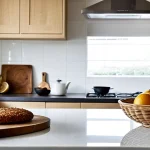Energy-Efficient Design Strategies in Modern UK Kitchens
Creating an energy-efficient kitchen design requires thoughtful planning to harness natural resources and reduce electricity use. One key strategy is smart appliance placement. Positioning appliances like dishwashers and refrigerators close to each other minimizes heat exchange with surrounding areas, enhancing kitchen energy savings. Additionally, situating frequently used appliances near natural light sources decreases the need for artificial lighting during the day.
Open-plan kitchens promote better airflow, which can lower the need for mechanical ventilation. This layout not only creates a spacious feel but also supports sustainable kitchen layouts by reducing energy used for heating or cooling. Strategic incorporation of windows and doors facilitates cross-ventilation, keeping the kitchen environment comfortable with less energy.
This might interest you : How is the UK Culinary Scene Adapting to Global Trends?
Passive design elements play an essential role. Insulation in walls and floors keeps heat in during winter and out in summer, significantly cutting energy consumption. Careful window orientation allows sunlight to naturally warm the space, reducing reliance on heaters. North-facing windows can provide consistent daylight without excessive heat, while south-facing ones maximize warmth during colder months.
Together, these strategies result in kitchens that are not only visually appealing but also highly functional and energy conscious, making a tangible impact on utility bills and environmental footprint.
Also read : Exploring the impact of sustainability on today’s uk kitchen design trends
Adoption of Sustainable Materials and Finishes
Choosing sustainable kitchen materials is a pivotal step towards an eco-friendly kitchen renovation. Homeowners increasingly prefer eco-friendly worktops made from recycled glass, bamboo, or composite quartz, which combine durability with environmental responsibility. These materials reduce reliance on virgin resources and minimize landfill waste.
In addition to worktops, green cabinetry options now include reclaimed woods and rapidly renewable materials like cork or fast-growing bamboo. These choices not only conserve forests but also add unique character to kitchen designs. Selecting cabinetry finished with low-VOC (volatile organic compounds) paints and sealants contributes to healthier indoor air quality by limiting harmful chemical emissions.
Brands in the UK market are embracing this shift. Several manufacturers offer certifications for responsibly sourced woods, such as FSC or PEFC, reassuring consumers of ethical supply chains. Popular products often feature finishes that are water-based and free of harmful solvents.
Adopting sustainable materials is more than an aesthetic choice; it addresses environmental concerns and supports healthier living spaces. When considering a kitchen upgrade, focusing on these sustainable kitchen materials and green cabinetry options ensures a blend of style, durability, and ecological mindfulness.
Energy-Saving Appliances and Cutting-Edge Technologies
Energy-efficient kitchen appliances are increasingly favored by modern UK designers aiming to reduce household energy consumption. Among these, induction cooking is a standout technology, offering rapid heat-up times and precise temperature control, which translates to lower energy use compared to traditional gas or electric cooktops.
UK kitchens are also adopting LED lighting extensively because of its long lifespan and minimal power consumption. Not only does this reduce electricity bills, but it also improves the overall kitchen environment with brighter, more consistent lighting.
Smart kitchen tech enhances savings by integrating smart controls, timers, and sensors that optimize appliance operation. For example, refrigerators with adaptive defrost cycles, or ovens that preheat only when needed, prevent unnecessary energy waste.
The combination of smart kitchen tech and energy-efficient appliances means homeowners can enjoy convenience without compromising on environmental responsibility. This holistic approach to kitchen design aligns with both sustainability goals and practical daily use, making it easier to cut energy costs effectively. Embracing these technologies can significantly reduce a household’s carbon footprint while providing modern, user-friendly cooking experiences.
Compliance with Regulations and Pursuing Certifications
Navigating UK energy regulations is vital when designing kitchen appliances or systems. One key standard is the Part L Building Regulations, which sets energy performance standards to reduce carbon emissions and improve efficiency in buildings. Compliance ensures kitchens meet legal energy-saving targets, aligning with broader environmental goals.
Designers often pursue kitchen energy certifications like Energy Saving Trust endorsements or Energy Performance Certificates (EPCs). These certifications validate appliance efficiency and promote transparency for consumers. An EPC rating, for instance, measures a kitchen’s overall energy use and impacts resale value or rental attractiveness.
Professionals guiding clients through these certifications help clarify complex legal requirements. They assess current designs against regulations and recommend modifications to boost efficiency without compromising functionality. This guidance streamlines the certification process, avoiding costly delays or non-compliance penalties.
Understanding and adhering to energy performance standards enhances a kitchen’s sustainability and cost-effectiveness. For stakeholders, this means not only regulatory compliance but also an opportunity to showcase environmental responsibility. Clients benefit from improved operational costs and potential incentives linked to certified energy-efficient designs.
Expert Insights and Notable Case Studies
In the realm of kitchen remodeling, UK kitchen designer case studies provide valuable lessons on marrying style with sustainability. Industry-leading experts emphasize designing kitchens that maximize energy efficiency without sacrificing aesthetics or functionality. For instance, several innovative kitchen remodels across the UK showcase the integration of smart lighting, energy-efficient appliances, and improved insulation to reduce energy consumption significantly.
Energy efficiency experts stress that beyond selecting efficient appliances, attention to layout and material choice can enhance heat retention and minimize waste. One notable case involved a London-based redesign where solar-powered under-cabinet lighting and an energy monitor system reduced the household’s kitchen energy use by 30%. These measurable outcomes illustrate the practical benefits clients enjoy, ranging from lower utility bills to environmental impact.
Leading designers recommend homeowners consider these principles when planning their projects. Incorporating renewable energy sources and selecting materials with low thermal conductivity leads to kitchens that perform better year-round. By learning from these UK kitchen designer case studies, homeowners can make informed choices that blend innovation with sustainability, achieving satisfying energy savings and long-term client satisfaction.

